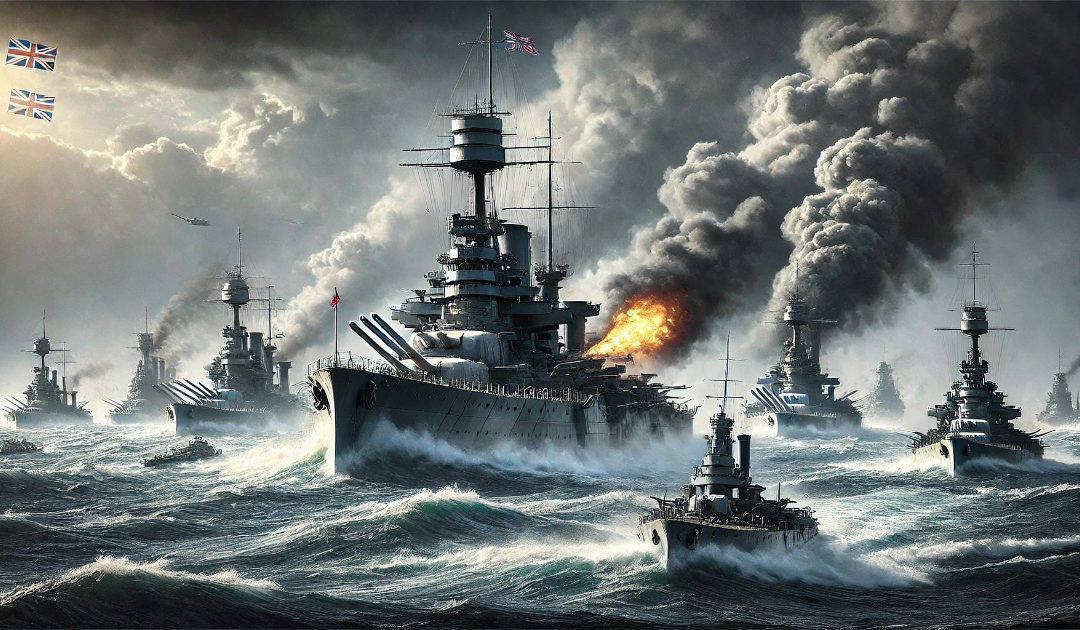The Battle of Jutland began on the 31st of May, 1916. This engagement involved the British Royal Navy’s Grand Fleet, commanded by Admiral Sir John Jellicoe, and the Imperial German Navy’s High Seas Fleet, led by Vice-Admiral Reinhard Scheer. Although the battle was tactically inconclusive, with both sides claiming victory, it had profound strategic implications, impacting the naval strategies of both empires for the remainder of the war.
The battle took place in the North Sea, near the coast of Denmark’s Jutland Peninsula. This strategic location was chosen because both the British and Germans were keen to assert dominance in these waters. The British, with their superior fleet, aimed to maintain a blockade that would strangle German supply lines. Conversely, the Germans sought to weaken the British fleet by launching an ambush, hoping to tip the balance of naval power in their favour.
In the build-up to the battle, British intelligence intercepted German communications, revealing plans for a sortie. This foresight allowed the British Grand Fleet to position themselves strategically, anticipating the German movements. The British fleet consisted of 28 battleships, nine battlecruisers, and numerous other vessels, making it a formidable force. The Germans, although smaller in number with 16 battleships and five battlecruisers, were determined to make a significant impact.
The battle commenced on the afternoon of the 31st of May, as both fleets encountered each other unexpectedly. The initial engagement saw the British battlecruiser squadron, under Vice-Admiral Sir David Beatty, clash with the German scouting group led by Vice-Admiral Franz Hipper. The opening salvos were marked by the tragic loss of two British battlecruisers, HMS Indefatigable and HMS Queen Mary, which were destroyed by accurate German gunfire.
As the battle unfolded, Admiral Jellicoe maneuvered the Grand Fleet into a position known as “crossing the T,” a tactic designed to allow maximum firepower against the enemy while minimizing return fire. Despite this advantage, the chaotic nature of naval warfare meant that maintaining formation was challenging, and both fleets found themselves locked in a deadly exchange of fire.
The arrival of darkness brought a shift in tactics. Night fighting posed unique challenges, with visibility reduced and the threat of torpedo attacks looming large. The Germans attempted to disengage under the cover of night, launching torpedo attacks to deter pursuit. Several skirmishes occurred throughout the night, with both sides suffering further losses.
When dawn broke on the 1st of June, the German High Seas Fleet had successfully retreated towards their home ports, eluding the Grand Fleet. The battle resulted in heavy losses for both sides. The British lost 14 ships and over 6,000 men, while the Germans lost 11 ships and around 2,500 men. On paper, the Germans could claim a tactical victory due to the higher number of British losses. However, strategically, the British retained control of the North Sea, continuing their blockade that would eventually contribute to Germany’s economic hardships.
The Battle of Jutland was the largest naval battle of World War I and highlighted the technological and tactical developments of naval warfare. It underscored the importance of naval intelligence, the challenges of night engagements, and the deadly effectiveness of modern naval artillery and torpedoes. Furthermore, the battle emphasised the strategic patience exhibited by the British, who understood that maintaining their naval blockade was more crucial than seeking a decisive battle.
In the aftermath of Jutland, both navies undertook rigorous analyses, leading to improvements in ship design and tactics. For the British, ensuring the robustness of battlecruiser armour became a priority, while the Germans focused on enhancing their fleet’s communication and night-fighting capabilities.

